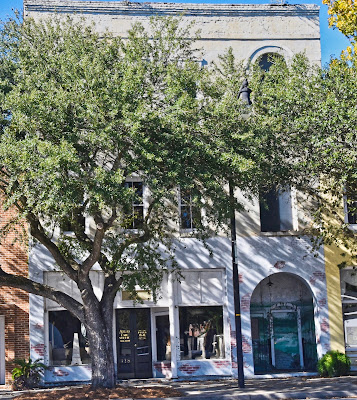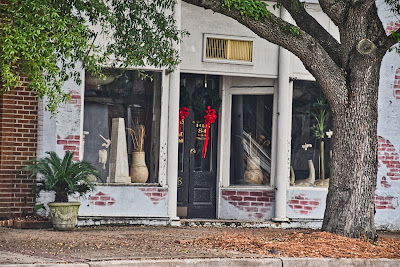One of the architectural differences that distinguish small towns from cities is that most buildings in a small town are usually only one, two or three stories tall. In 2019, Kingstree, South Carolina, has only three buildings that are three-stories high. The first of those, built on Main Street in 1904 on a lot which in the 1870s held a mercantile business owned by Edwin Harper, was called during its construction, The Gourdin Skyscraper.
The "skyscraper" as it looks today.
P.G. Gourdin broke ground for the three-story building across the street from the Williamsburg County Courthouse in April 1904. He expected to complete the building in October, but that deadline seemed doubtful when construction had to cease for a time because the iron beam needed to support the upper stories was long delayed in getting to Kingstree. However, once it arrived, work went on at a feverish pace, and Saul Marcus was able to hold a grand opening for his dry goods store on the ground floor on October 22, 1904. Saul and Anne Marcus would continue to operate their store in this building until July, 1913, when they moved into a new three-story building just down the street.
S. Marcus, painted on the side of the building, is still faintly visible.
In the months after the Marcuses vacated the Gourdin building, the first floor was the used by the community as a place to hold hot suppers or bazaars for the benefit of local churches and civic organizations.
In March, 1914, Dr D.C. Scott used the first floor as a temporary home for his drugstore while he built a new building on the site of his old one on Academy Street. After he moved into his new drugstore, the first floor of the Gourdin building was renovated to house the revived Kingstree Dispensary, the state-run method of dispensing liquor in South Carolina. Williamsburg County had been a "dry" county for a number of years, but voters had, in 1914, agreed that dispensaries could be re-established in the county.
The first floor of the Gourdin Building in 2019.
When the dispensary closed once again with the onset of Prohibition in 1917, the Electrical Supply Company took over the building's first floor, but by February 1921, H.C. Crawford had moved his shoe repair shop into the building. After only a short stay, he moved into one of the W.I. Nexsen buildings down the block, and in September of that year, the Williamsburg Distributing Company moved in. This company was organized to handle field, truck, and garden seeds and plants. C. J. Thompson managed the business, and that September, he was advertising wheat and rye seeds, as well as strawberry plants. I don't know how long this business occupied the building, but in January, 1930, The Coffee Shoppe had moved into a remodeled and renovated first floor.
The County Record, the town's weekly newspaper, leased the second floor of the building, even before it was completed. Problems with equipment delayed their moving in until February 1905. The County Record closed the week between Christmas 1906 and New Year's 1907 to install a new gasoline engine in the smaller building located behind the "skyscraper." The gasoline engine was to run the press, and this necessitated making alterations to the press room as well. By the end of January, 1907, the engine had already ceased to function, much to the dismay of the newspaper staff. However, their dismay at this development was mild compared to the consternation of replacing the press in March, 1912. "We never fully appreciated the power of the press until we undertook the job of lifting to and lowering from a second-story window a five-ton piece of machinery." Even with W.R. Funk and his son, Ernest, lending the news staff a block and tackle to help with the job, the paper was two days late in publishing that week. The paper would do business from that office for almost 20 years.
The addition off the back of the building housed the gasoline engine
use to power The County Record's press.
After the newspaper moved to new quarters, building owner P.G. Gourdin, who had maintained his office on the third floor of the building for many years, moved downstairs into the space vacated by The County Record. Part of the second floor was also used as overflow storage for another member of the Gourdin family. Martha Wolff owned many antiques, some of which she had inherited from the Gourdin and Boyd families, and others that she had collected. According to the January 12, 1929, News & Courier, "When her house overflowed, she stored the excess in a room of the Gourdin building." The paper noted that among these antiques were a Hepplewhite dining table, a Chippendale chest of drawers, and a Duncan Phyfe sofa. She also reportedly had a Stradivarius violin stored in a vault.
The third floor of the building was used by Kingstree Magistrate, Richard Wallace, as his office for several years. In later years, the Woodmen of the World used the third floor as their meeting place. On June 9, 1920, the Loyal Order of the Moose used the Woodmen of the World hall to organize a Moose Lodge with 60 charter members. The Boy Scouts also used the third floor for their meetings. However, in 1929, the Boy Scouts were displaced when the Georgia-Carolina School of Commerce began offering classes on the third floor of the building. The school was directed by Laura Lynch, a former member of the Kingstree High School faculty. Seven received diplomas after completing the seven-month course. The school closed after its first session, and Scout Master, the Rev. John W. Davis, returned the Boy Scouts to the third floor of the building.
The archway which once led to a barber shop and later a pressing club.
The arched portion of the first floor of the building, led to what was used originally as a barber shop. John Mouzon had his barbershop in this part of the building until he moved to the Kellahan Hotel. When Mouzon moved, Jeff Fulton established a pressing club in this space. The pressing club provided services of washing and pressing, primarily men's shirts. On July 24, 1909, a fire which started in the pressing club's quarters endangered the whole building. Fulton had gone home to lunch, leaving a small boy in charge of the shop. A three-burner kerosene stove was left burning, and while he was gone, gasoline came in contact with the stove, causing an explosion. John Mouzon happened to be walking down Main Street toward his shop when he saw the blaze and managed to extinguish it before it caused serious damage. A little over a year later, in October, 1910, another small fire at the pressing club was quickly extinguished, although The County Record noted that "a business such as this is a risk to all other downtown businesses."





No comments:
Post a Comment